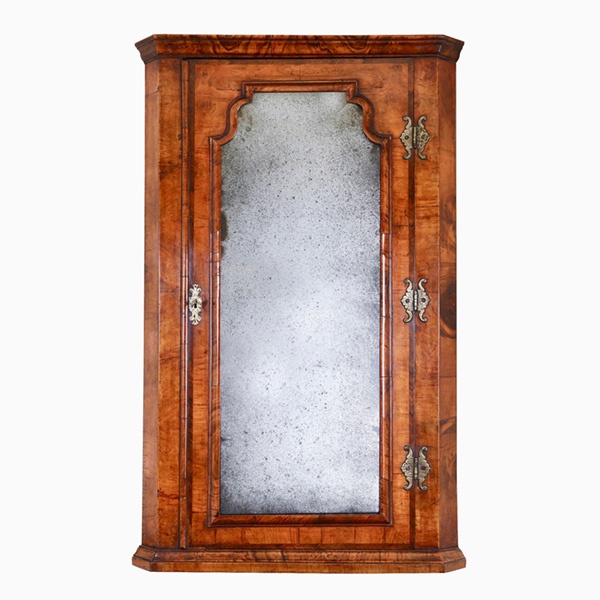A Small 18th century George I period table clock by Gamaliel Voyce, c.1725
Sold
Request Information
Follow Us
A Small 18th century George I period table clock by Gamaliel Voyce, c.1725
An extremely attractive early 18th century George I period table clock of small proportions by Gamaliel Voyce, c.1725.
The proportions of the petite clock (measuring only 14 inches (36cm) with the handle up) are such that is difficult not to fall in love with it. The timepiece has a five knopped and finely finned pillar gut-fusee movement with verge escapement and a short knife-edge suspended pendulum. It has a pull quarter repeat on two vertically positioned bells indicating the hours on the larger bell followed by the quarter hours sounding a ting-tang strike on both bells. The profusely engraved backplate and verge cock apron depict symmetrical floral and scrolling leaf and vine patterns around a prominent signature cartouche: Gam Voyce London.
The break-arch brass dial has a silvered chapter ring, a circular signature plaque to the arch, date aperture right under the middle and a false pendulum aperture under the XII. The chapter ring has Roman numerals within a minute ring and an outer Arabic five-minute track. The dial centre is finely matted and the gilt-brass corner spandrels are of the crown and sceptre design, while the arch spandrels depict putti looking outwards. The time is indicated by a fine pair of pierced blued steel hands.
The ebonised fruitwood veneered oak case has an inverted bell top surmounted by a brass swinging carrying handle, well-formed and returned top moulding and door edge moulding. All sides are glazed so that the fine movement is almost entirely visible. The arched side panels are surmounted by smaller shaped windows. Both doors have fretted quadrants backed with red silk and well-formed elaborated concave mouldings.
Condition
Good. Wear consistent with age and use. The case is in superb and original condition. The movement is fully restored and keeps very good time.
Dimensions
Height: 14.57 in. (37 cm)
Width: 7.88 in. (20 cm)
Depth: 5.91 in. (15 cm)
Literature
Dowler G. Gloucestershire Clock and Watchmakers. 1984, Phillimore, Chichester, pp. 102-107; Grange M. A bell ringer’s clock. Antiq Hor 1998; 24(3): 210-216.
PREVIOUSLY SOLD
No Results Found
The page you requested could not be found. Try refining your search, or use the navigation above to locate the post.
No Results Found
The page you requested could not be found. Try refining your search, or use the navigation above to locate the post.
YOU MAY ALSO LIKE

17th Century Figured Walnut and Seaweed Marquetry Lace Box
17th Century Figured Walnut and Seaweed Marquetry Lace Box £3,600 Follow Us17th Century Figured Walnut and Seaweed Marquetry Lace Box A fine and extremely rare figured walnut and seaweed marquetry 'lace box', circa.... let’s break it down -...

19th Century Repeating Gilt-Brass Carriage Clock by the Famous Drocourt
19th Century Repeating Gilt-Brass Carriage Clock by the Famous Drocourt £5,600 Follow Us19th Century Repeating Gilt-Brass Carriage Clock by the Famous Drocourt A superb repeating carriage clock with a gilt-brass gorge case by the famous maker...

17th-Century Hague Clock Signed by Pieter Visbagh, circa 1675
Small 17th Century Hague clock made c. 1675 by Pieter Visbagh, who was apprenticed by Salomon Coster. The latter made the first pendulum clock according to the instructions of Christiaan Huygens, the internationally renowned scientist who developed the idea of applying a pendulum to a clock movement.

Pair of 18th-Century English Rococo Gilt Bronze Andirons or Firedogs
An exceptional pair of 18th century English Rococo gilt bronze andirons or fire dogs.
The bold shape of these andirons relate to designs of Thomas Johnson (1714–1778), one of London’s pioneers of the ‘Modern’ or French style, later known as Rococo.

Queen Anne Walnut Corner Cupboard with Bevelled Mirror Plate
A truly remarkable find in original condition. To the door a shaped soft bevelled mirror plate is framed by a cross-grain molding of typical queen Anne design which is further cross-banded, feather-banded and edged to the opening with a single de-molding.

17th Century Figured Walnut and Seaweed Marquetry Lace Box
17th Century Figured Walnut and Seaweed Marquetry Lace Box £3,600 Follow Us17th Century Figured Walnut and Seaweed Marquetry Lace Box A fine and extremely rare figured walnut and seaweed marquetry 'lace box', circa.... let’s break it down -...

19th Century Repeating Gilt-Brass Carriage Clock by the Famous Drocourt
19th Century Repeating Gilt-Brass Carriage Clock by the Famous Drocourt £5,600 Follow Us19th Century Repeating Gilt-Brass Carriage Clock by the Famous Drocourt A superb repeating carriage clock with a gilt-brass gorge case by the famous maker...

17th-Century Hague Clock Signed by Pieter Visbagh, circa 1675
Small 17th Century Hague clock made c. 1675 by Pieter Visbagh, who was apprenticed by Salomon Coster. The latter made the first pendulum clock according to the instructions of Christiaan Huygens, the internationally renowned scientist who developed the idea of applying a pendulum to a clock movement.

Pair of 18th-Century English Rococo Gilt Bronze Andirons or Firedogs
An exceptional pair of 18th century English Rococo gilt bronze andirons or fire dogs.
The bold shape of these andirons relate to designs of Thomas Johnson (1714–1778), one of London’s pioneers of the ‘Modern’ or French style, later known as Rococo.

Queen Anne Walnut Corner Cupboard with Bevelled Mirror Plate
A truly remarkable find in original condition. To the door a shaped soft bevelled mirror plate is framed by a cross-grain molding of typical queen Anne design which is further cross-banded, feather-banded and edged to the opening with a single de-molding.









